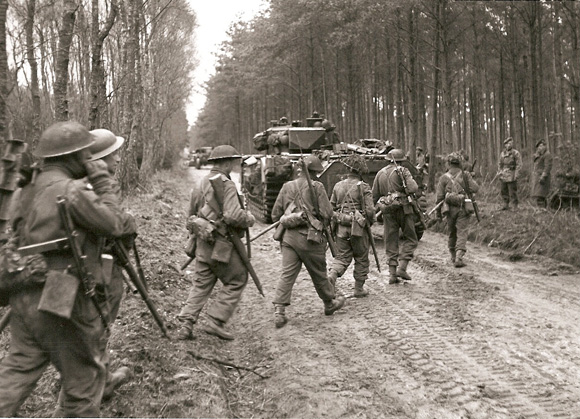
2nd Seaforth Account of the Reichswald Battles February 1945.
Important western European Theater battle, marking the opening phase of Operation VERITABLE, the advance of Lieutenant General Henry Crerar’s Canadian First Army to the Rhine River. The offensive had First Army pushing across the German-Dutch border, securing Cleve, and then turning south between the Rhine and the Maas Rivers to meet Lieutenant General William H. Simpson’s U. S. Ninth Army as it was driving northeast across the Roer River and toward the Rhine in Operation GRENADE. The Allies hoped to surround and destroy defending German units and secure crossing points over the Rhine. To accomplish this, Canadian forces, reinforced by the British army’s XXX Corps, would have to cross the heavily wooded Reichswald State Forest and eliminate the German pillboxes and bunkers of the West Wall (known to the Allies as the Siegfried Line).
The Allied force committed to this effort eventually numbered 200,000 men. General Alfred Schlemm’s First Parachute Army of Army Group H defended the area. Schlemm sought to prevent the Allies from breaking through and seizing the bridgeheads over the lower Rhine. The Allied attack was hindered to some extent by the terrain- there were only two roads through the Reichswald Forest- and by the weather. A thaw just before the attack turned the ground into mud, and the Germans opened floodgates on the Maas, overflowing the river and flooding the countryside. As a consequence, the battle, planned to last only a few days, dragged on for several weeks.
The assault began on 8 February 1945 with a five-hour artillery barrage by 1,000 Allied guns. British Lieutenant General Sir Brian Horrocks’s XXX Corps led the attack, which consisted of (from north to south) the 3rd and 2nd Canadian, the 15th Scottish, the 53rd Welsh, and the 51st Highland Divisions. Delays in the advance, however, enabled Schlemm to bring up reserves, as well as Mark IV tanks and assault guns of the Panzer Lehr Division.
By opening the gates of the Roer River dams, the Germans forced Simpson to postpone Ninth Army’s attack for almost two weeks. By the time the Ninth Army launched what was to have been a supporting attack on 23 February, the Canadian and British troops had already achieved almost all their objectives. Supported by massive artillery barrages and air support, the Canadian and British infantry troops slowly forced the German defenders from their defensive positions. The Germans fought particularly hard in and around the critical towns of Cleve, Goch, and Calcar. The Canadian II Corps suffered heavy losses advancing east of Cleve, and the British XXX Corps sustained considerable casualties near Goch.
British and Canadian forces took 15,634 casualties, nearly two-thirds of which were in XXX Corps. General Horrocks later wrote that the brutal Reichswald fighting reminded him of the carnage in World War I. The operation had cost the German army as well. Losses sustained by the 11 German divisions involved have been estimated from as low as 22,000 to as high as 75,000 men; some 16,000 Germans were taken prisoner. The commitment of so many German reserves to the fighting in the Reichswald helped to open the way for U. S. advances farther south.